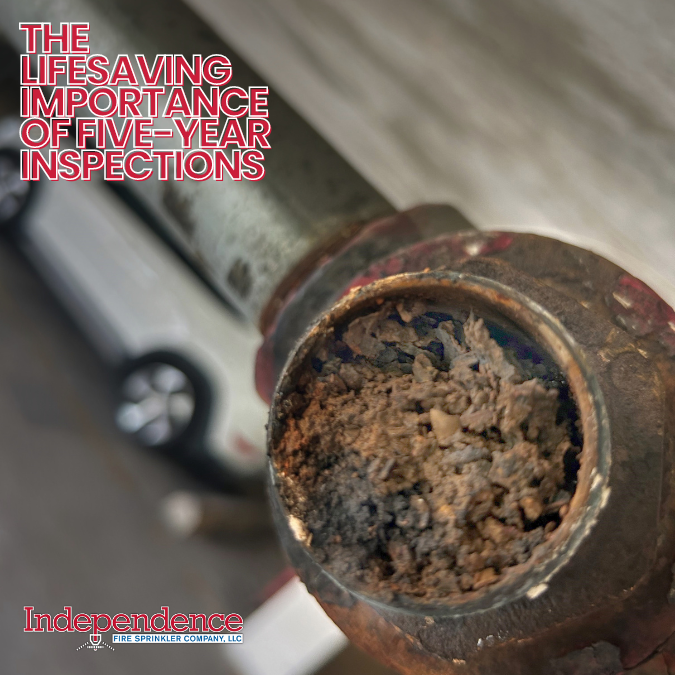Maintaining fire protection systems with consistent inspections is critical to ensure that they perform as expected during an emergency. While monthly, quarterly, and annual inspections focus on routine checks, the five-year inspection provides a deeper assessment of the system’s overall health. These inspections target the more complex and harder-to-reach components, preventing long-term issues that could compromise the system’s integrity. For this reason, they are required by Chapter 14 of NFPA 25, the Standard for the Inspection, Testing, and Maintenance of Water-Based Fire Protection Systems. As a building’s first line of defense in the event of a fire, fire protection systems can deteriorate over time due to corrosion, wear, or environmental factors – issues that may not be visible during regular inspections. The five-year inspection takes a closer look at these components, ensuring the system remains fully functional and compliant with safety regulations.
Internal Piping Integrity: One of the most critical aspects of the five-year inspection is assessing the internal condition of the piping. As the system ages, piping in fire protection systems can experience buildup of debris, corrosion, and microbial growth. With time, these obstructions can resist the flow of water and reduce a system’s ability to suppress a fire effectively. The five-year inspection calls for an internal pipe examination to detect and address these potential blockages before they compromise the system’s performance.
Ensuring Proper Valve and Gauge Operation: Valves and gauges play a vital role in regulating and monitoring water flow and pressure within the system. During the five-year inspection, fitters thoroughly test these components to ensure they’ll operate as expected during an emergency. Malfunctioning valves and gauges in need of calibration can lead to a system failure at the time it’s needed most, making these checks a key part of maintaining system reliability.
Standpipe and Hose Systems: In buildings equipped with standpipe and hose systems, the five-year inspection requires a methodical evaluation of the condition and functionality of these systems. This includes checking for obstructions, testing for leaks, and ensuring the hoses are in good condition. Standpipes play a crucial role in delivering water to the upper floors and remote areas, so their inspection is necessary for maintaining complete fire protection functionality.
Fire Department Connection (FDC): The Fire Department Connection (FDC) is the component which allows fire departments to connect to a building’s fire protection system and supply additional water during a fire. The five-year inspection guarantees that the FDC is free of obstructions and fully functional for use during an emergency. Confirming that these connections are in proper working order is key to ensuring your system will have the water supply necessary to control a fire.
Antifreeze Solution Testing: For systems that utilize antifreeze solutions in areas prone to freezing temperatures, the concentration and effectiveness of the antifreeze must be checked during the five-year inspection. Over time, the antifreeze can break down and lose effectiveness. When this is not addressed, the system’s performance is compromised in cold conditions. Testing during the five-year inspection ensures that the antifreeze solution remains effective for firefighting purposes and within compliance of NFPA standards.
Sprinkler Head Integrity: Checking the condition of the sprinkler heads is one of the most crucial facets of the five-year inspection. All sprinkler heads will degrade over time, especially those located in harsh environments such as areas prone to corrosion, dirt, or extreme temperatures. The five-year inspection includes an evaluation of the condition of sprinkler heads, replacing any that show signs of corrosion, damage, or wear. By ensuring each sprinkler head is fully functional, building owners can avoid scenarios where a failed sprinkler head compromises the system’s ability to control or extinguish a fire.
Compliance with NFPA Standards: With all things related to business, we must consider liability. NFPA 25 requires that all water-based fire protection systems undergo a comprehensive five-year inspection to remain compliant with industry standards. Regular compliance with NFPA standards helps building owners avoid being liable for legal and financial penalties, as well as ensuring that the building’s fire protection systems meet the highest safety requirements.
The Long-Term Benefits: Building owners and facility managers can significantly extend the lifespan of their fire protection systems by conducting these five-year inspections. Regular inspections help identify and address minor issues before they evolve into major problems that require expensive repairs or system overhauls. Moreover, maintaining a well-functioning fire protection system improves overall safety, reduces the risk of fire-related damage, and ensures peace of mind that the system will work at the time you count on it most.
Conclusion: Five-year inspections of fire protection systems are not merely an administrative task to check off of the to-do list; they are a proactive step in maintaining the health and functionality of a building’s fire suppression infrastructure. Ensuring that internal piping, valves, gauges, standpipes, hoses, and sprinkler heads are all in top condition helps prevent system failures and reduces the risk of catastrophic fire damage. By adhering to NFPA 25 and conducting thorough five-year inspections, building owners can safeguard their property, protect lives, and count on their fire protection system performing reliably during an emergency.
Stay protected. Stay compliant. Schedule your five-year fire protection system inspection today.

